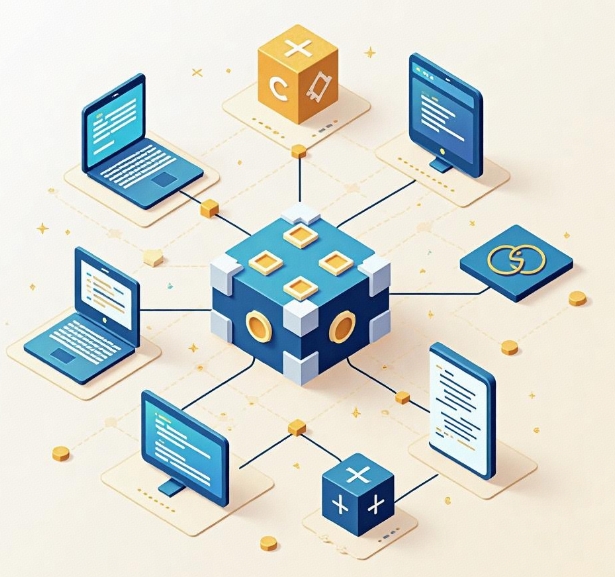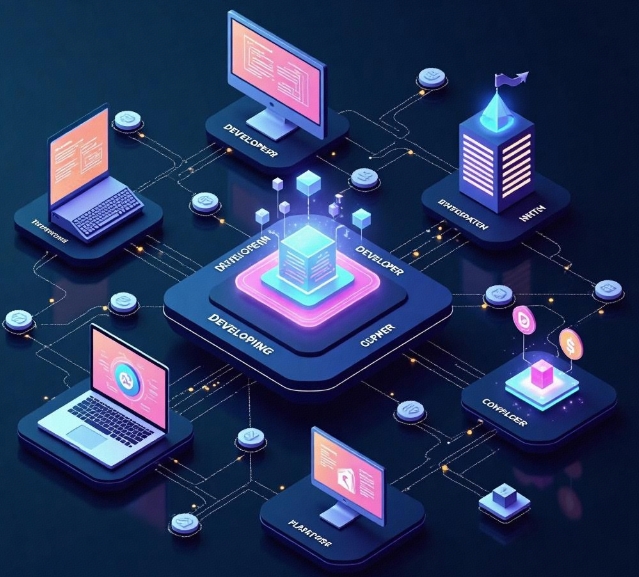Market and Ecosystem Analysis in DApp Development
- latest articles
- 1.DApp Development & Customization: Merging Diverse Market Needs with User Experience 2.Analysis of the Core Technical System in DApp Project Development 3.How to achieve cross-chain interoperability in Web3 projects? 4.How does the tokenization of points reconstruct the e-commerce ecosystem? 5.How to Set and Track Data Metrics for a Points Mall? 6.What is DApp Development? Core Concepts and Technical Analysis 7.Inventory of commonly used Web3 development tools and usage tips 8.Development of a Distribution System Integrated with Social E-commerce 9.Six Key Steps for Businesses to Build a Points Mall System 10.What is DApp Development? A Comprehensive Guide from Concept to Implementation
- Popular Articles
- 1.Future Trends and Technology Predictions for APP Development in 2025 2.Analysis of the DeFi Ecosystem: How Developers Can Participate in Decentralized Finance Innovation 3.From Zero to One: How PI Mall Revolutionizes the Traditional E-commerce Model 4.DAPP Development | Best Practices for Professional Customization and Rapid Launch 5.Recommended by the Web3 developer community: the most noteworthy forums and resources 6.From Cloud Computing to Computing Power Leasing: Building a Flexible and Scalable Computing Resource Platform 7.How to Develop a Successful Douyin Mini Program: Technical Architecture and Best Practices 8.Shared Bike System APP: The Convenient Choice in the Era of Smart Travel 9.How to Create a Successful Dating App: From Needs Analysis to User Experience Design 10.From Design to Development: The Complete Process of Bringing an APP Idea to Life
As an important component of blockchain technology applications, Decentralized Applications (DApps) have garnered increasing attention from developers, investors, and technical researchers in recent years. The emergence of DApps has revolutionized traditional application development and operation methods. Their underlying decentralized architecture can effectively avoid single points of failure, enhance data security, and create a more fair and transparent application environment.
In the development process of DApps, market environment and ecosystem play crucial roles. Understanding these factors not only helps developers make more accurate decisions during development but also provides market guidance for investors and enterprises. This article will analyze the current market development status, ecosystem composition, and future trends of DApps to help readers comprehensively understand the development and application prospects of DApps.
Overview of DApp Development
DApps are applications based on blockchain technology that use smart contracts to implement decentralized functionalities. Unlike traditional applications, the core characteristic of DApps is decentralization, meaning they do not rely on any single server or centralized institution to control and store data. This gives DApps features such as immutability, transparency, and strong autonomy, enabling them to avoid certain trust issues present in traditional applications.
DApp development typically involves the following steps:
Choosing a Blockchain Platform: Currently, mainstream blockchain platforms include Ethereum, EOS, and Tron. Developers need to select an appropriate blockchain platform based on their application's requirements.
Smart Contract Development: Smart contracts are the core component of DApps, defining the application's business logic through code. Ethereum is the most common smart contract platform, and developers can use Solidity language for coding.
Frontend and Blockchain Interaction: The frontend of a DApp typically interacts with the blockchain through libraries like Web3.js to connect with smart contracts.
Deployment and Testing: After development, DApps require thorough testing to ensure stable operation on the blockchain.
Current Challenges in DApp Development
Despite the advantages of decentralization, DApp development and promotion still face several challenges:
Poor User Experience: Due to the unique nature of blockchain technology, DApps have a high barrier to entry, and average users may encounter complex operations during use.
Scalability Issues: Many blockchain platforms have slow transaction speeds, leading to longer response times for DApps and negatively impacting user experience.
Legal and Compliance Issues: The decentralized nature of DApps makes regulation challenging, and issues related to finance and privacy protection may face regulatory hurdles.
Analysis of the Current DApp Market
With the continuous development of blockchain technology, the DApp market is gradually maturing. Data shows that the number and activity of DApps have been growing over the past few years, spanning multiple industries such as finance, gaming, and social networking.
Market Size
The global DApp market has reached tens of billions of dollars and is showing rapid growth momentum. According to the latest market reports, blockchain applications are most widely adopted in the financial sector, particularly driven by decentralized finance (DeFi) and stablecoins, which have widely recognized the market potential of DApps. Additionally, gaming DApps are also expanding their market share, attracting a large number of users and developers.
Market Trends
Key development trends in the DApp market include:
The Rise of DeFi: Decentralized finance (DeFi) has become one of the most dynamic areas in the DApp market. DeFi applications use smart contracts to implement functions such as lending, trading, and payments, reducing intermediary costs and increasing transparency.
The Popularity of NFTs: Non-fungible tokens (NFTs) have also become a highlight in the DApp space. NFTs provide a decentralized platform for authentication and trading of digital art, gaming assets, and more, attracting a large number of creators and investors.
Development of Cross-Chain Technology: With the gradual advancement of multi-chain technology, cross-chain interoperability of DApps has become a focus of market attention. Developers can enable the flow of assets and data across different blockchain platforms, enhancing the scalability and flexibility of DApps.
DApp Ecosystem
The DApp ecosystem is a complex, multi-layered network involving several key elements, including blockchain platforms, development tools, users, miners, protocols, and communities.
Blockchain Platforms
Blockchain platforms provide the infrastructure and execution environment for DApps. Current mainstream blockchain platforms include:
Ethereum: Ethereum is the most mature and widely used DApp development platform, with robust smart contract support and a strong developer community.
EOS: EOS offers higher transaction throughput through its DPoS consensus mechanism and is a blockchain platform tailored for enterprise-level applications.
Tron: Tron focuses on the entertainment and content creator sectors, providing an optimized experience for DApps with its high transaction speed and low transaction costs.
Development Tools
Development tools are indispensable in the DApp development process. Commonly used tools include:
Truffle: An Ethereum smart contract development framework that provides a rich set of tools for development, testing, and deployment.
Metamask: A browser extension that enables interaction with the Ethereum blockchain, facilitating developers and users in engaging with DApps.
IPFS: A distributed storage protocol that offers decentralized data storage solutions for DApps.
Users and Miners
The user base for DApps is continuously expanding, particularly in the DeFi and NFT sectors, attracting a large number of investors and average users. Miners play a crucial role in decentralized applications by participating in transaction validation and block production, ensuring network security and decentralization.
Community and Protocols
The success of DApps relies on community support and protocol development. Developer communities provide a continuous source of innovation and updates for DApps, while open protocols ensure interoperability and consensus mechanisms between different DApps.
Ongoing Development and Trends
The future development of DApps will be influenced by multiple factors, including technology, market demand, and legal policies. Some potential future trends include:
More Enterprise-Level Applications: As technology continues to improve, an increasing number of enterprises are exploring DApps in areas such as supply chain management and financial services, positioning DApps to become part of mainstream applications.
Advancements in Legal Compliance: As DApps become more widespread, governments worldwide will gradually introduce relevant regulations to standardize the development of decentralized applications, providing legal safeguards for their long-term growth.
Technological Innovation: With the continuous development of blockchain technology, DApp development tools and technical architectures will become more mature, supporting higher performance and lower-cost applications.
Conclusion
The market and ecosystem of DApps are in a phase of rapid development. Despite facing numerous challenges, the future prospects of DApps remain broad, driven by technological innovation and growing market demand. Developers, investors, and users will all play important roles in this process, collectively advancing the continuous development of decentralized applications.
-

DApp Development & Customization: Merging Diverse Market Needs with User Experience
As blockchain technology matures and becomes more widespread, decentralized appl···
-

Analysis of the Core Technical System in DApp Project Development
With the rapid development of blockchain technology, decentralized applications ···
-

What is DApp Development? Core Concepts and Technical Analysis
With the rapid development of blockchain technology, decentralized applications ···

 Blockchain
Blockchain












